|
|
|
Sort Order |
|
|
|
Items / Page
|
|
|
|
|
|
|
| Srl | Item |
| 1 |
ID:
110363
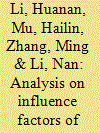

|
|
|
|
|
| Publication |
2011.
|
| Summary/Abstract |
With the intensification of global warming and continued growth in energy consumption, China is facing increasing pressure to cut its CO2 (carbon dioxide) emissions down. This paper discusses the driving forces influencing China's CO2 emissions based on Path-STIRPAT model-a method combining Path analysis with STIRPAT (stochastic impacts by regression on population, affluence and technology) model. The analysis shows that GDP per capita (A), industrial structure (IS), population (P), urbanization level (R) and technology level (T) are the main factors influencing China's CO2 emissions, which exert an influence interactively and collaboratively. The sequence of the size of factors' direct influence on China's CO2 emission is A>T>P>R>IS, while that of factors' total influence is A>R>P>T>IS. One percent increase in A, IS, P, R and T leads to 0.44, 1.58, 1.31, 1.12 and -1.09 percentage change in CO2 emission totally, where their direct contribution is 0.45, 0.07, 0.63, 0.08, 0.92, respectively. Improving T is the most important way for CO2 reduction in China.
|
|
|
|
|
|
|
|
|
|
|
|
|
|
|
|
| 2 |
ID:
124719


|
|
|
|
|
| Publication |
2013.
|
| Summary/Abstract |
The combination of bioenergy production and carbon capture and storage technologies (BECCS) provides an opportunity to create negative emissions of CO2 in biofuel production. However, high capture costs reduce profitability. This paper investigates carbon price uncertainty and technological uncertainty through a real option approach. We compare the cases of early and delayed CCS deployments. An early technological progress may arise from aggressive R&D and pilot project programs, but the expected cost reduction remains uncertain. We show that this approach results in lower emissions and more rapid investment returns although these returns will not fully materialise until after 2030. In a second set of simulations, we apply an incentive that prioritises sequestered emissions rather than avoided emissions. In other words, this economic instrument does not account for CO2 emissions from the CCS implementation itself, but rewards all the sequestered emissions. In contrast with technological innovations, this subsidy is certain for the investor. The resulting investment level is higher, and the project may become profitable before 2030. Negative emission in bioethanol production does not seem to be a short-term solution in our framework, whatever the carbon price drift.
|
|
|
|
|
|
|
|
|
|
|
|
|
|
|
|
| 3 |
ID:
122740


|
|
|
|
|
| Publication |
2013.
|
| Summary/Abstract |
As the capital of China, Beijing is regarded as a major metropolis in the world. Study of the variation in temporal CO2 emissions generated by the driving forces in Beijing can provide guidance for policy decisions on CO2 emissions mitigation in global metropolises. Based on input-output structural decomposition analysis (IO-SDA), we analysed the driving forces for the increment in CO2 emissions in Beijing from both production and final demand perspectives during 1997-2010. According to our results, the CO2 emission growth in Beijing is driven mainly by production structure change and population growth, partly offset by CO2 emission intensity reduction as well as the decline in per capita final demand volume during the study period. Final demand structure change has a limited effect on the change in the CO2 emissions in Beijing. From the final demand perspective, urban trades, urban residential consumption, government consumption and fixed capital formation are mainly responsible for the booming emissions. This study showed how the "top-down" IO-SDA methodology was implemented on a city scale. Policy implications from this study would be helpful for addressing CO2 emissions mitigation in global capital cities and metropolises.
|
|
|
|
|
|
|
|
|
|
|
|
|
|
|
|
| 4 |
ID:
096736


|
|
|
|
|
| Publication |
2010.
|
| Summary/Abstract |
Significant pressure from increasing CO2 emissions and energy consumption in China's industrialization process has highlighted a need to understand and mitigate the sources of these emissions. Ammonia production, as one of the most important fundamental industries in China, represents those heavy industries that contribute largely to this sharp increasing trend. In the country with the largest population in the world, ammonia output has undergone fast growth spurred by increasing demand for fertilizer of food production since 1950s. However, various types of technologies implemented in the industry make ammonia plants in China operate with huge differences in both energy consumption and CO2 emissions. With consideration of these unique features, this paper attempts to estimate the amount of CO2 emission from China's ammonia production, and analyze the potential for carbon mitigation in the industry. Based on the estimation, related policy implications and measures required to realize the potential for mitigation are also discussed.
|
|
|
|
|
|
|
|
|
|
|
|
|
|
|
|
| 5 |
ID:
097591


|
|
|
|
|
| Publication |
2010.
|
| Summary/Abstract |
Significant pressure from increasing CO2 emissions and energy consumption in China's industrialization process has highlighted a need to understand and mitigate the sources of these emissions. Ammonia production, as one of the most important fundamental industries in China, represents those heavy industries that contribute largely to this sharp increasing trend. In the country with the largest population in the world, ammonia output has undergone fast growth spurred by increasing demand for fertilizer of food production since 1950s. However, various types of technologies implemented in the industry make ammonia plants in China operate with huge differences in both energy consumption and CO2 emissions. With consideration of these unique features, this paper attempts to estimate the amount of CO2 emission from China's ammonia production, and analyze the potential for carbon mitigation in the industry. Based on the estimation, related policy implications and measures required to realize the potential for mitigation are also discussed.
|
|
|
|
|
|
|
|
|
|
|
|
|
|
|
|
| 6 |
ID:
133271
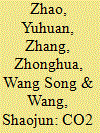

|
|
|
|
|
| Publication |
2014.
|
| Summary/Abstract |
In light of the growth in vertically specialized in global trade, the present paper uses input- output tables from the World Input-Output Database to construct an environmental multi-regional input-output model to calculate the CO2 emissions embodied in China's international trade during 1995-2009. The advantage of this model lies in its incorporation of the re-exported CO2 emissions component embodied in trade and its ability to differentiate domesticsourced CO2 emissions from foreign-sourced CO2 emissions in trade. The results show that carbon emissions embodied in both China's exports and imports increased significantly during 1995-2009. One important reason for this is that the re-exported carbon emissions embodied in China's imported intermediate inputs increased substantially during this period. Our research reveals that accelerating the transformation of trade pattern and upgrading processing trade should be emphasized in the formulation of policy to prompt CO2 emissions abatement in China.
|
|
|
|
|
|
|
|
|
|
|
|
|
|
|
|
| 7 |
ID:
103443


|
|
|
|
|
| Publication |
2011.
|
| Summary/Abstract |
This study evaluates the changes in CO2 emissions from energy consumption in Brazil for the period 1970-2009. Emissions are decomposed into production and consumption activities allowing computing the full set of energy sources consumed in the country. This study aims to develop a comprehensive and updated picture of the underlying determinants of emissions change from energy consumption in Brazil along the last four decades, including for the first time the recently released data for 2009. Results demonstrate that economic activity and demographic pressure are the leading forces explaining emission increase. On the other hand, carbon intensity reductions and diversification of energy mix towards cleaner sources are the main factors contributing to emission mitigation, which are also the driving factors responsible for the observed decoupling between CO2 emissions and economic growth after 2004. The cyclical patterns of energy intensity and economy structure are associated to both increments and mitigation on total emission change depending on the interval. The evidences demonstrate that Brazilian efforts to reduce emissions are concentrated on energy mix diversification and carbon intensity control while technology intensive alternatives like energy intensity has not demonstrated relevant progress. Residential sector displays a marginal weight in the total emission change.
|
|
|
|
|
|
|
|
|
|
|
|
|
|
|
|
| 8 |
ID:
178831


|
|
|
|
|
| Summary/Abstract |
This study scrutinizes the impact of globalization, non-renewable energy consumption, and economic growth on CO2 emission for selected South Asian economies during 1985–2018 under the EKC framework. For this purpose, we apply a fully modified ordinary least square (FMOLS) technique. The empirical findings of this study identify that globalization is positively associated with CO2 emission. The results also indicate that non-renewable energy consumption increasing environmental pollution. Moreover, the results confirm the EKC hypothesis in the South Asian region; this means that at the early stages of development, when economic growth increases, environmental pollution also increases, but environmental degradation starts to decrease with the increases in economic growth after the threshold point. The empirical outcomes suggest that the government should subsidize and promote renewable energy sources to tackle the problem of environmental degradation.
|
|
|
|
|
|
|
|
|
|
|
|
|
|
|
|
| 9 |
ID:
126594


|
|
|
|
|
| Publication |
2013.
|
| Summary/Abstract |
The primary focus of this research is to explore the effect of pro-environmental behaviour on CO2 emissions in relation to heating, electricity and transport activities in the residential sector. Changing such behaviour has considerable potential for conserving energy and is an important target of environmental policies which are designed to decrease energy consumption. It is hypothesized that people who consciously act in a pro-environmental way do not necessarily have lower CO2 emissions more than those who do not undertake environmental activities. Data about residential energy use is based on a survey carried out in Hungary in 2010 with a sample of 1012 people. Latent cluster analysis (LCA) was conducted based on data about the reported pro-environmental behavior in the survey and four clusters were identified. Relevant sociostructural and structural factors were also inverstigated.
Results of the data analysis show that no significant difference is found between the impacts of environmentally aware and environmentally unaware consumers, i.e. both 'Brown' and 'Supergreen' consumers consume approximately the same amount of energy and produce approximately the same amount of carbon emissions because the motivation-driven activities of 'Supergreens' are offset by structural factors.
|
|
|
|
|
|
|
|
|
|
|
|
|
|
|
|
| 10 |
ID:
171413
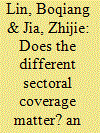

|
|
|
|
|
| Summary/Abstract |
By the end of 2017, China formally established the national carbon trading market, however, only electricity industry was eligible to participate in the emission trading scheme (ETS). This paper aims to answer the question as to what should China do after the first step of establishing China's national ETS market using a dynamic recursive CGE model with six scenarios from different coverage according to relevant documents. The results show that when more industries are covered in ETS market it will lead to a higher GDP performance and less ETS price in general. Since the trading price is related to the marginal emission reduction cost of enterprises, the coverage of enterprises with low emission reduction cost can bring lower prices. However, there is no direct relationship between carbon price and emission reduction, as the coverage is different in different. There is no obvious relationship between the additional burden of enterprises and emission reduction, it is only related to carbon price and the coverage. Finally, we find that after covering the power generation industry, the carbon market should cover other primary energy production enterprises, which will bring much better emission reduction benefits than the original plan of the National Development and Reform Commission in China.
|
|
|
|
|
|
|
|
|
|
|
|
|
|
|
|
| 11 |
ID:
115152
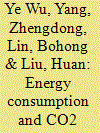

|
|
|
|
|
| Publication |
2012.
|
| Summary/Abstract |
Vehicle electrification has been seriously considered as an industry revolution to achieve sustainable transportation in China. Hybrid electric vehicles (HEV), plug-in hybrid electric vehicles (PHEV) and pure electric vehicles (EV) are being demonstrated in scores of large cities. We select three well-developed regions (Jing-Jin-Ji, Yangtze-River-Delta and Pearl-River-Delta) to explore regional growth patterns for the light-duty passenger vehicle fleet and develop various scenarios for the penetration of HEV, PHEV and EV during 2010-2030. Per-kilometre and fleet well-to-wheels (WTW) petroleum use, fossil energy and CO2 emissions are evaluated among various technology options. Promotion of PHEV and EV could help cut per-kilometre petroleum use to a great extent; however, to achieve a clear reduction benefit in oil demand for a fleet in three regions takes time. The effort to mitigate CO2 emissions is much more difficult than lowering fossil energy use or oil consumption. This is especially true for the Jing-Jin-Ji Region where coal is an overwhelming power source. In those regions with a high share of coal power, HEV is a better option than PHEV or EV to reduce WTW CO2 emissions. In the Pearl-River-Delta region with a much cleaner electricity mix, promotion of EV could achieve a more significant CO2 reduction.
|
|
|
|
|
|
|
|
|
|
|
|
|
|
|
|
| 12 |
ID:
116763


|
|
|
|
|
| Publication |
2012.
|
| Summary/Abstract |
We analyze the change of energy consumption and CO2 emissions in China's cement industry and its driving factors over the period 1990-2009 by applying a log-mean Divisia index (LMDI) method. It is based on the typical production process for clinker manufacturing and differentiates among four determining factors: cement output, clinker share, process structure and specific energy consumption per kiln type. The results show that the growth of cement output is the most important factor driving energy consumption up, while clinker share decline, structural shifts mainly drive energy consumption down (similar for CO2 emissions). These efficiency improvements result from a number of policies which are transforming the entire cement industry towards international best practice including shutting down many older plants and raising the efficiency standards of cement plants. Still, the efficiency gains cannot compensate for the huge increase in cement production resulting from economic growth particularly in the infrastructure and construction sectors. Finally, scenario analysis shows that applying best available technology would result in an additional energy saving potential of 26% and a CO2 mitigation potential of 33% compared to 2009.
|
|
|
|
|
|
|
|
|
|
|
|
|
|
|
|
| 13 |
ID:
119843


|
|
|
|
|
| Publication |
2013.
|
| Summary/Abstract |
China's carbon dioxide (CO2) emission ranks highest in the world. China is committed to reduce its CO2 emission by 40% to 45% from the 2005 levels by 2020. To fulfill the target, China's CO2 emission reduction must exceed 6995 million tons. Energy consumption and CO2 emission of China's urban district heating (UDH) are increasing. The current policy implemented to improve UDH focuses on replacing coal with natural gas to reduce energy consumption and CO2 emission to some extent. This paper proposes that heat pump heating (HPH) could serve as a replacement for UDH to help realize energy-saving and emission-reduction goals to a greater extent. The paper also analyzes the impact of this replacement on the heating and power generation sectors. The results show that replacing coal-based UDH with HPH decreases energy consumption and CO2 emission by 43% in the heating sector. In the power generation sector, the efficiency of power generation at the valley electricity time increases by 0.512%, and the ratio of peak-valley difference decreases by 16.5%. The decreases in CO2 emission from the heating and power generation sectors cumulatively account for 5.55% of China's total CO2 emission reduction target in 2020.
|
|
|
|
|
|
|
|
|
|
|
|
|
|
|
|
| 14 |
ID:
122737


|
|
|
|
|
| Publication |
2013.
|
| Summary/Abstract |
The industrial sector has accounted for more than 50% of China's final energy consumption in the past 30 years. Understanding the future emissions and emissions mitigation opportunities depends on proper characterization of the present-day industrial energy use, as well as industrial demand drivers and technological opportunities in the future. Traditionally, however, integrated assessment research has handled the industrial sector of China in a highly aggregate form. In this study, we develop a technologically detailed, service-oriented representation of 11 industrial subsectors in China, and analyze a suite of scenarios of future industrial demand growth. We find that, due to anticipated saturation of China's per-capita demands of basic industrial goods, industrial energy demand and CO2 emissions approach a plateau between 2030 and 2040, then decrease gradually. Still, without emissions mitigation policies, the industrial sector remains heavily reliant on coal, and therefore emissions-intensive. With carbon prices, we observe some degree of industrial sector electrification, deployment of CCS at large industrial point sources of CO2 emissions at low carbon prices, an increase in the share of CHP systems at industrial facilities. These technological responses amount to reductions of industrial emissions (including indirect emission from electricity) are of 24% in 2050 and 66% in 2095.
|
|
|
|
|
|
|
|
|
|
|
|
|
|
|
|
| 15 |
ID:
088962


|
|
|
|
|
| Publication |
2009.
|
| Summary/Abstract |
The grey forecasting model, GM(1,1) was adopted in this study to capture the development trends of the number of motor vehicles, vehicular energy consumption and CO2 emissions in Taiwan during 2007-2025. In addition, the simulation of different economic development scenarios were explored by modifying the value of the development coefficient, a, in the grey forecasting model to reflect the influence of economic growth and to be a helpful reference for realizing traffic CO2 reduction potential and setting CO2 mitigation strategies for Taiwan. Results showed that the vehicle fleet, energy demand and CO2 emitted by the road transportation system continued to rise at the annual growth rates of 3.64%, 3.25% and 3.23% over the next 18 years. Besides, the simulation of different economic development scenarios revealed that the lower and upper bound values of allowable vehicles in 2025 are 30.2 and 36.3 million vehicles, respectively, with the traffic fuel consumption lies between 25.8 million kiloliters to 31.0 million kiloliters. The corresponding emission of CO2 will be between 61.1 and 73.4 million metric tons in the low- and high-scenario profiles.
|
|
|
|
|
|
|
|
|
|
|
|
|
|
|
|
| 16 |
ID:
125622


|
|
|
|
|
| Publication |
2013.
|
| Summary/Abstract |
This paper introduces the Global Resource Balance Table (GRBT), which is an extension of the energy balance tables that expresses the relationships between energy, materials and the environment. The material division of the GRBT includes steel, cement, paper, wood and grain. In contrast, the environmental division of the GRBT includes oxygen, CO2 and methane. The transaction division rows in the GRBT include production, conversion, end use and stock. Each cell of the GRBT contains the quantities of the respective resources that were generated or consumed. The relationships between the cells were constructed from the laws of conservation of the materials and energy. We constructed a GRBT for 2007 and discussed the increasing air temperature due to waste heat and the CO2 equivalent from human breathing. The GRBT is a comprehensive integrated table that represents the resources that are consumed by human activities and is useful for energy and environmental studies.
|
|
|
|
|
|
|
|
|
|
|
|
|
|
|
|
| 17 |
ID:
136204
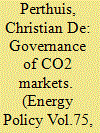

|
|
|
|
|
| Summary/Abstract |
The European emissions trading scheme (EU ETS) is the centerpiece of Europe׳s climate policy. The system has been undermined variously by the weakness of its regulation, an undesirable overlap with other public policies and the far-reaching economic and financial crisis that caused the market price of allowances to plunge. This article attempts to identify the conditions for making the coming years of the EU ETS a success. It draws historical lessons from the eight years the scheme has been in operation, and then presents the various interventions by the public authorities currently under discussion in order to revive the market. Finally, the article proposes to draw lessons from monetary policy by outlining what might be the mandate of an Independent Carbon Market Authority, with responsibility for the dynamic management of the supply of allowances, and whose main mission would be to ensure the optimal linkage between the different temporal horizons of the climate strategy. This article could provide important lessons for schemes developing in the rest of the world, especially in South Korea or in China.
|
|
|
|
|
|
|
|
|
|
|
|
|
|
|
|
| 18 |
ID:
176102


|
|
|
|
|
| Summary/Abstract |
There are cross subsidies in China's power industry and there is a gap between supply cost and the sales price of electricity to residents and enterprises. Enterprises pay for part of residents' electricity bills. As cross subsidies always have been criticized, this paper simulates counterfactual scenarios of removing cross subsidy by applying a dynamic recursive computable general equilibrium model. Based on the scenario analysis, the elimination of cross subsidy will have positive impact on economic performance, but negative on CO2 mitigation, industrial structure, and social welfare. Eliminating cross subsidies can reduce commodity prices, improve the competitiveness of enterprises, especially power-intensive enterprises. However, China is somehow an export-oriented country. Only a part of the benefits of the decrease in the product price is obtained by domestic households. Maybe removing cross subsidies is not a good policy in this kind of countries. However, under the background of power system reform, cross subsidy may not last long, and the price will not be regulated. With the marketization of electricity trading, appropriate imposed environmental tax or carbon tax will be more conducive to China's low-carbon development.
|
|
|
|
|
|
|
|
|
|
|
|
|
|
|
|
| 19 |
ID:
103469


|
|
|
|
|
| Publication |
2011.
|
| Summary/Abstract |
This paper investigates the impact of the economic recession on CO2 emissions in the European power sector, during the years 2008 and 2009. Three main determinants of the power sector's emissions are identified: the demand for electricity, the CO2 price, and fuel prices. A counterfactual scenario has been set up for each of these, i.e., what these parameters would have been if not affected by the recession. A simulation model of the European power sector is then employed, comparing a historical reference simulation (taking the parameters as actually occurred) with the counterfactual scenarios. The lower electricity demand (due to the recession) is shown to have by far the largest impact, accounting for an emission reduction of about 175 Mton. The lower CO2 price (due to the recession) resulted in an increase in emissions by about 30 Mton. The impact of fuel prices is more difficult to retrieve; an indicative reduction of about 17 Mton is obtained, mainly as a consequence of the low gas prices in 2009. The simulated combined impact of the parameters results in an emission reduction of about 150 Mton in the European power sector over the years 2008 and 2009 as a consequence of the recession.
|
|
|
|
|
|
|
|
|
|
|
|
|
|
|
|
| 20 |
ID:
116988


|
|
|
|
|
| Publication |
2012.
|
| Summary/Abstract |
Some traditional industrial regions are characterized by high industrial proportion and large CO2 emission. They are facing dual pressures of maintaining economic growth and largely reducing CO2 emission. From the perspective of study of typological region, taking the typical traditional industrial region-Liaoning Province of China as a case, this study establishes a system dynamics model named EECP and dynamically simulates CO2 emission trends under different conditions. Simulation results indicate, compared to the condition without CO2 emission reduction policies, CO2 emission intensity under the condition of implementing CO2 emission reduction policies of "Twelfth Five-Year Plan" is decreased by 11% from 2009 to 2030, but the economic cost is high, making the policies implementation faces resistance. Then some improved policies are offered and proved by EECP model that they can reduce CO2 emission intensity after 2021 and decrease the negative influence to GDP, realizing the improvement objects of reducing CO2 emission and simultaneously keeping a higher economy growth speed. The improved policies can provide reference for making and improving CO2 emission reduction policies in other traditional industrial regions with large CO2 emission. Simultaneously, EECP model can provide decision-makers with reference and help for similar study of energy policy.
|
|
|
|
|
|
|
|
|
|
|
|
|
|
|
|
|
|
|
|
|